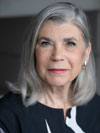 |
| Leading surveyor: Louise Brooke-Smith |
Meanwhile the similarity in career profiles of women reaching the top of these
august bodies continues to fascinate. Louise Brooke-Smith has run her own
business since 1994 – an independent businesswoman just like Jean Venables
(first woman President of the Institution of Civil Engineers, Ruth Reid and
Angela Brady, first women Presidents of the RIBA, Pam Liversidge, first woman
President of the Institution of Mechanical Engineers, and so on ……) See Women rulers.
Just the entrepreneurial spirit,
as well as academic and professional excellence, that government wants to
encourage. Moreover, the pipeline of female
potential appears to be filling fast, with 984,000 female undergraduates studying for
degrees, compared to 713,000 male across UK universities. The gap is expected
to widen in future years as new government rules make it easier for
universities to recruit students with A-level grades of AAB or better, more of
whom are female.
 |
| TV role model? Vet Trude Mostue |
But there are voices
of caution. The Chief Executive of the Universities and Colleges
Admissions Service, Mary Curnock Cook, describes the gap between male and
female performance at school and university as very worrying and ‘which will
lead to fundamental shifts in society’.
One institution particularly concerned about female
domination of its profession is the Royal Veterinary College, where 75% of newly
qualified vets are female, predicted to rise to 90% by 2015. The RVC is now classifying
white males as a minority group in its latest recruitment campaign.
So in this
increasingly female profession who and where are the women at the top? The first
woman president of the Royal College of Veterinary Surgeons (RCVS) was Dame
Olga Uvarov an orphaned, malnourished seven year-old rescued from the Russian
Revolution and brought to London by her uncle in 1917. She qualified as a vet
in 1934 and formed her own practice before being elected President of the RCVS
in 1976. Another entrepreneur who
originated outside Britain (see Must women have to leave home to be successful),
amongst her many achievements is a research medal in her honour and a bequest
to provide education and travel scholarships for young people.
 |
| Dame Olga Uvarov: survived to achieve |
It
has been difficult to find out just how many women presidents of the RCVS there
have been since Dame Olga– I believe there have been three – as the data is
incomplete and thin. But there were rather more women movers and shakers in the
British Veterinary Association (BVA), than the Royal College. Nine
years before the Royal College elected Dame Olga Uvarov, the British
Veterinary Association elected its
first woman president, the extraordinarily able and inspirational Mary Brancker.
She was a leading light in the
Society of Women Veterinary Surgeons, formed in 1941 by Joan
Joshua and Margaret Bentley as a division of the BVA. Its foundation was sparked by the difficulties
women veterinary surgeons faced at the beginning of WWII. During the war,
Veterinary Surgery was a ‘reserved profession’; male vets didn’t have to join the
fighting and could keep their jobs. It was a different story for female
vets however, as they were immediately redirected to essential
war work. Joan Joshua challenged the Ministry of Labour in person and, within
ten days of her complaint being lodged, the situation was rectified.
Throughout
its existence of almost fifty years the Society pledged to keep a ‘watching
brief’ over issues which would affect women in the profession. It offered women support, organised lectures on
topics such as exotic animal care, arranged educational visits and in 1969 set
up a Trust which gave grants for professional development.
By 1989, female
graduating veterinary surgeons were in the majority; with 54% of new members
added to the Register of Veterinary Surgeons that year being women. So members
of the SWVS decided that it had achieved its purpose and, just shy of its
Golden Jubilee in 1990, dissolved the Society. However it is interesting to
note that it took nearly 40 years for the second woman, Dr Freda
Scott-Park from Dunbartonshire, to be elected president of the BVA in 2005.
So
the hoppers of talented women in the workplace are filling up, even in engineering
where the percentage of girls seeing it as a desirable career has risen from
21% in 2011 to 25% in 2012. (Figures from EngineeringUK's brand monitor.) London 2012 has also inspired women to embark on
careers in construction and engineering, with 500 apprenticeships being given
against a target of 350 and nearly 1,000 women in the construction workforce.
But
some pipelines still seem to be leaking, evidenced in architecture for example
where far more women study than practice, and there remain issues about women’s
inclination or opportunity to reach the top in some sectors.
As Diane Houston, a
psychology professor and graduate school dean at Kent University, commented
this week, whilst boys may be disadvantaged at school, women still faced a
glass ceiling in the workplace. As she comments, “I’m not sure that at this
point we should be screaming about percentage differences in attainment given
the way in which women’s careers atrophy through their reproductive lives.
There may be more women training to be solicitors, but the judges are men.”
What
is the solution, I wonder? As well as
declaring white men a minority in universities, applying a limit to the number
of women going on to further education? Applying
a marking handicap to girls, to give boys the edge, like they did in the 11
plus examinations back in the 1950s? (I was one of these handicapped girls, but
still got my place at grammar school.) Outlawing women’s groups and societies?
Or should we resist any thoughts of social engineering and simply leave it to
natural selection?





No comments:
Post a Comment